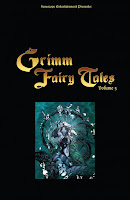GFT Retrospective #30: The Little Mermaid Collection
Hello again, Ticketholders and other click-bait enthusiasts!
It's been several days since the four-part Spider-Man: Homecoming special (the collected edition of which can be accessed here), and almost two weeks since a Grimm Fairy Tales Retrospective hit the interwebs despite my many promises to the contrary.
And before you read the rest of the post, you can download and read the Volume 5 Trade Paperback from this link.
And before you read the rest of the post, you can download and read the Volume 5 Trade Paperback from this link.
So to recapitulate and recapture the latest focus of the Ticketverse, Sela Mathers is dead, leaving Belinda with free reign over the lost souls of the world as we head into the fifth volume of the first volume of Grimm Fairy Tales, beginning with this pair of milestone issues.
GFT #25 & 26: The Little Mermaid Collection
Next on Belinda's list is the mother of a college student named Sara.
After reading some of The Little Mermaid (which is not technically one of the Brothers’ Grimm’s original Fairy Tales, but instead a work of Hans Christian Anderson), Sara’s mother gets impatient waiting for her education to pay off and convinces Sara that quicker, easier money can be made by selling herself and conning rich men.
The fairy tale plays out mostly according to the common knowledge/Disney version, but for a few minor changes. When a ship is lost to a storm (perhaps the same ship and storm briefly mentioned in The Lamp short story), a group of sirens abduct the drowning sailors, except for one, whose instinctive feelings for a prince lead her to rescue him and deposit him ashore. Later, the Little Mermaid sells her voice to the sea witch for human legs and gets herself discovered by the prince, who seems as smitten with her as she is with him. The royal family is quick to provide her and us with commentary on the archaic but still prevalent view of women as animals and objects. Further compounding this, and reinforcing my suspicions that this is the same womanizing prince from The Lamp, he later chooses a noblewoman--read: a higher-value possession--over the Little Mermaid, breaking her heart and making her reconsider her deal with the sea witch.
This is another unique pair of issues (yes, I realize the multiple ironies of the phrase “another unique pair”), as the fairy tale frames the modern day story--it both begins the first issue and ends the second issue, as well as unfolding on the page alongside modern events--wherein Sara’s mother’s plans lead to Sara falling for a celebrity athlete named Stephen, who is sleeping with another woman. Whether he is married to her or just a womanizer isn’t explained and doesn’t seem to matter. The other woman doesn’t even get a name in the story, I guess to further comment on the exploitation of women as sexual objects…?
As the Little Mermaid’s siren sisters are giving her an enchanted blade to kill the unfaithful prince and break the sea witch’s contract, Belinda convinces Sara’s mother to give Sara a gun to kill Stephen. The Little Mermaid takes pity on the prince and is later captured by the sea witch, with the prince coming to her rescue. That he does this while she is in mermaid form is meant to be a sign that he truly loves her despite her outward appearance, but could just as easily be seen as him viewing her as a rare and even more valuable possession than the noblewoman. Whatever his motives, his efforts prove to be in vain.
Sara’s efforts at revenge likewise prove to be in vain because she’s never used a gun before and Belinda is Belinda. The story ends with Sara in prison for attempted murder and pregnant with Stephen’s daughter, and the sea witch living to bargain for more mermaid souls because in Belinda’s fairy tales, the villains always win.
I enjoyed the painting-like art style of these issues, and despite the negative outcome and minimal exposure of the modern side of events, I enjoyed reading the story as well. My only real gripe (as with quite a chunk of the Grimm and Wonderland storylines so far) is the lack of care and attention to time.
We know through past issues that the fairy tales presented by both Sela and Belinda are to some degree repressed memories or past lives for those they are presented to. But in part two of The Little Mermaid, some events of the fairy tale are referred to as “Present Day” to distinguish it from flashbacks and flash-forwards that occur within the tale, which I found confusing. At one point, the focus shifts from The Little Mermaid to the real present day of the story, which is referred to simply as “Now.” Aren’t “Present Day” and “Now” the same thing? If you still own a hard copy of a Thesaurus (or you have the internet and you know how to type “thesaurus.com”), look it up.
In the meantime, stay tuned for more whosits and whatsits galore.
Ticketmaster,
out.
Ticketmaster,
out.





Comments
Post a Comment